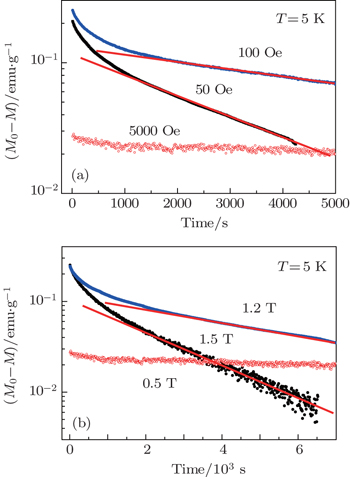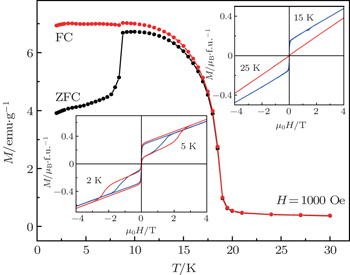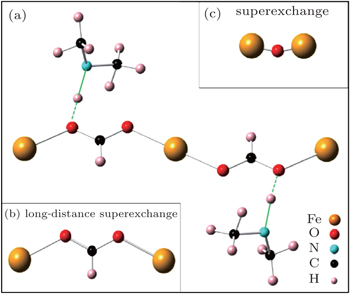† Corresponding author. E-mail:
Project supported by the National Natural Science Foundation of China (Grant Nos. 11227405, 51371192, and 51371193) and the Chinese Academy of Sciences (Grant No. XDB07030200).
The hybrid metal–organic framework [(CH 3 ) 2 NH 2 ]Fe(HCOO) 3 with a perovskite-like structure exhibits a variety of unusual magnetic behaviors at low temperatures. While the long-distance super-exchange through the Fe-O–CH-O–Fe exchange path leads to a canted antiferromagnetic ordering at T N ∼ 19 K, a second transition of magnetic blocking develops at T B ∼ 9 K. The stair-shaped magnetization hysteresis loops below T B resemble the behaviors of resonant quantum tunneling of magnetization in single-molecular quantum magnets. Moreover, the magnetic relaxation also exhibits several features of resonant quantum relaxation, such as the exponential law with a single characteristic relaxation time, and the nonmonotonic dependence of relaxation rate on the applied magnetic field with a much faster relaxation around the resonant fields. The origin of quantum tunneling behaviors in the [(CH 3 ) 2 NH 2 ]Fe(HCOO) 3 metal–organic framework is discussed in terms of magnetic phase separation due to the modification of hydrogen bonding on the long-distance super-exchange interaction.
Hybrid inorganic–organic materials represent a new family in condensed matter physics. [ 1 ] The metal–organic frameworks (MOFs) consisting of networks of metal ions connected by coordinating organic linkers are good examples of such kind of hybrid materials. [ 2 ] Their great potential in applications such as catalytics, solar cells, and gas storage/separation has received intensive investigations in the last decade. [ 3 – 5 ] Meanwhile, the electric and magnetic properties of the hybrid MOFs are attracting more and more attention. [ 6 – 10 ] The MOFs can have diverse organic linkers (like CN, Cl, and C 2 O 4 ) and form different structures. In particular, the MOFs of ABX 3 perovskite-like structure with formate linkers (O–CH–O) lie in the focus of this field because they show interesting magnetic properties and even multiferroics. For instance, the perovskite MOFs with a general formula of [(CH 3 ) 2 NH 2 ] M (HCOO) 3 ] ( M = Zn, Mn, Co, Fe, Ni) have been synthesized and studied. [ 11 – 16 ] Among them, the MOF with M = Fe 2+ (d 6 ) is of special interest because it exhibits very unusual magnetic behaviors as well as magnetoelectric multiferroicity at low temperatures.
The Fe-MOF has an ABX 3 perovskite-like structure. The metal cations ( B = Fe 2+ ) bridged by the formate groups ( X = HCOO − ) form the BX 3 frameworks, and the dimethylammonium (DM A + ) cations ( A = [(CH 3 ) 2 NH 2 ] + ) occupy the cavities of the frameworks. In addition, the A groups are bonding to the formate linkers through the hydrogen bonds between the amine hydrogen atoms and the oxygen atoms of the formate bridges. Previous studies have revealed that the DM A + cations go through a dynamic disorder to a cooperative order upon cooling from the room temperature through 164 K due to the ordering of hydrogen bonding (N–H … O). [ 13 ] Furthermore, the hydrogen bonds have been proved to play an important role in the correlation between the B -site magnetic ions and the A -site organic cation. [ 8 , 15 ]
Recently, we have reported the observation of resonant quantum tunneling of magnetization in this Fe-MOF. [ 17 ] In this work, we focus on magnetic relaxation at low temperatures in the Fe-MOF. The results further demonstrate several features of resonant quantum relaxation, such as the exponential law with a single characteristic relaxation time, and the nonmonotonic dependence of the relaxation rate on the applied magnetic field, with enhanced relaxation around the resonant fields. The unusual magnetic behaviors of the Fe-MOF are discussed in terms of magnetic phase separation due to the modification of hydrogen bonding on the long-distance super-exchange interaction.
Single crystal samples of Fe-MOF were prepared by the hydrothermal method. A 30-mL N,N-Dimethylformamide (DMF) solution containing 5-mmol ferrous chloride salts and 30-mL deionized water was heated in a polyphenyl (PPL)-lined autoclaves for 3 days at 140 °C. [ 12 ] Then, cubic colorless crystals were obtained after slow evaporation for several days. The crystals were washed by ethanol several times, and then stored in a protective inert-gas atmosphere.
The x-ray diffraction (XRD) experiments of powder and single crystals were performed at room temperature using a Rigaku x-ray diffractometer. Powder XRD patterns have confirmed the structure and phase purity of the obtained samples. The single-crystal XRD pattern suggests that the crystal is naturally grown along [012] direction. All the magnetic properties were measured with a superconducting quantum interference device magnetometer (Quantum Design MPMS XL) on a single crystal along the [012] direction which is the magnetic easy axis.
The magnetic transitions in the Fe-MOF are checked by measuring the temperature dependence of magnetization with an applied field of 1000 Oe after a zero-field-cooled (ZFC) or field-cooled (FC) process. As shown in Fig.
One unique feature of Fe-MOF is that it exhibits stair-shaped M – H hysteresis loops below T B = 9 K. As shown in Fig.
 | Fig. 2. (a) The stair-shaped M – H hysteresis loops at T = 2 K and 5 K, obtained after subtracting the linear component. (b) The differential of M – H curves at 2 K and 5 K. |
In order to further confirm the nature of quantum tunneling of magnetization in Fe-MOF, we have carried on a series of magnetic relaxation experiments at 5 K along the easy axis [012]. First, the sample was cooled from 40 K (at which it is in the paramagnetic state) to 5 K in zero field, then the magnetic field was applied and the magnetization was measured with time. The relaxation behavior at low magnetic fields and high magnetic fields are displayed in Figs.
 | Fig. 3. Exponential magnetic relaxation at T = 5 K in (a) low magnetic fields and (b) high magnetic fields. The solid lines are the linear fits to the data. |
As seen in Figs.
Both the stair-shaped hysteresis loop and the exponential relaxation with a nonmonotonic field dependence are characteristics of resonant quantum tunneling of magnetization.
In the following, we try to understand the unusual magnetic behaviors of the Fe-MOF based on a long-distance super-exchange model. In transition-metal oxides, the transition-metal cations are separated by one oxygen atom and the magnetic ordering is due to super-exchange (Fig.
As illustrated in Fig.
The perovskite Fe-MOF exhibits very unusual magnetic behaviors at low temperatures, characterized by two magnetic transitions, and the resonant quantum tunneling of magnetization, as evidenced by the stair-shaped magnetization hysteresis loops and the nonmonotonic field dependence of exponential magnetic relaxation. The coexistence of two magnetic phases, i.e., canted antiferromagnetic ordering and single-ion quantum magnets, is interpreted by taking into account the action of hydrogen bonds on the long-distance super-exchange through a formate group linker. We propose that the hydrogen bonds can determine magnetic interaction by modifying the geometry of exchange path. This is very likely when the exchange path is long so that it is more sensitive to disturbances and distortions, such as in the hybrid metal–organic frameworks.
| 1 | |
| 2 | |
| 3 | |
| 4 | |
| 5 | |
| 6 | |
| 7 | |
| 8 | |
| 9 | |
| 10 | |
| 11 | |
| 12 | |
| 13 | |
| 14 | |
| 15 | |
| 16 | |
| 17 | |
| 18 | |
| 19 | |
| 20 | |
| 21 | |
| 22 | |
| 23 | |
| 24 | |
| 25 | |
| 26 | |
| 27 | |
| 28 |





